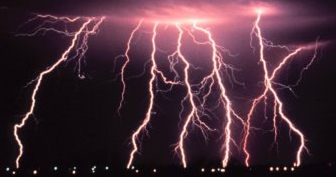|
We see static electricity every day. It can even build up on us. For example, when we rub our feet on the carpet and then zap something when we touch it. That is static electricity that we have built up on the surface of our skin discharging onto another object. We also see it when our hair gets charged and sticks straight up or when our pant legs keep sticking to our legs no matter what we try and do. This is all static electricity that has built up on the surface of an object.

Lightning is a powerful form of static electricity
What is static electricity?
In the study of atoms we learned that atoms are made up of neutrons, protons, and electrons. The electrons are spinning around the outside. A static charge is formed when two surfaces touch each other and the electrons move from one object to another. One object will have a positive charge and the other a negative charge. Rubbing the items quickly, like when you rub a balloon fast over something or your feet on the carpet, will build up a large charge. Items with different charges (positive and negative) will attract, while items with similar charges (positive and positive) will push away from each other. Sort of like a magnet.
Remember when you've gone down a slide and all your hair stands up straight. This is because the friction of sliding has caused a positive charge to be built up on each hair. Since each hair has the same charge, they all try to push away from each other and end up standing up straight.
Likewise, when your skin is charged with static electricity and you touch something metal, like a door handle, the metal is very conductive and will quickly discharge the static electricity, creating a zap or small spark.
Does it have any real uses?
Static electricity has several uses, also called applications, in the real world. One main use is in printers and photocopiers where static electric charges attract the ink, or toner, to the paper. Other uses include paint sprayers, air filters, and dust removal.
It can damage electronics
Static electricity can also cause damage. Some electronic chips, like the kind that are in computers, are very sensitive to static electricity. There are special bags to store these in. Also, people that work with these kind of electronics wear special straps that keep them "grounded" so they won't build up charge and ruin the electronic components.
Fun facts about static electricity
- A spark of static electricity can measure thousands of volts, but has very little current and lasts for a short period of time. This means it has little power or energy.
- Lighting is a powerful and dangerous example of static electricity.
- As dangerous as lighting is, around 70% of people struck by lightning survive.
- Temperatures in a lightning bolt can hit 50,000 degrees F.
- Static electricity will be worse on a dry non-humid day.